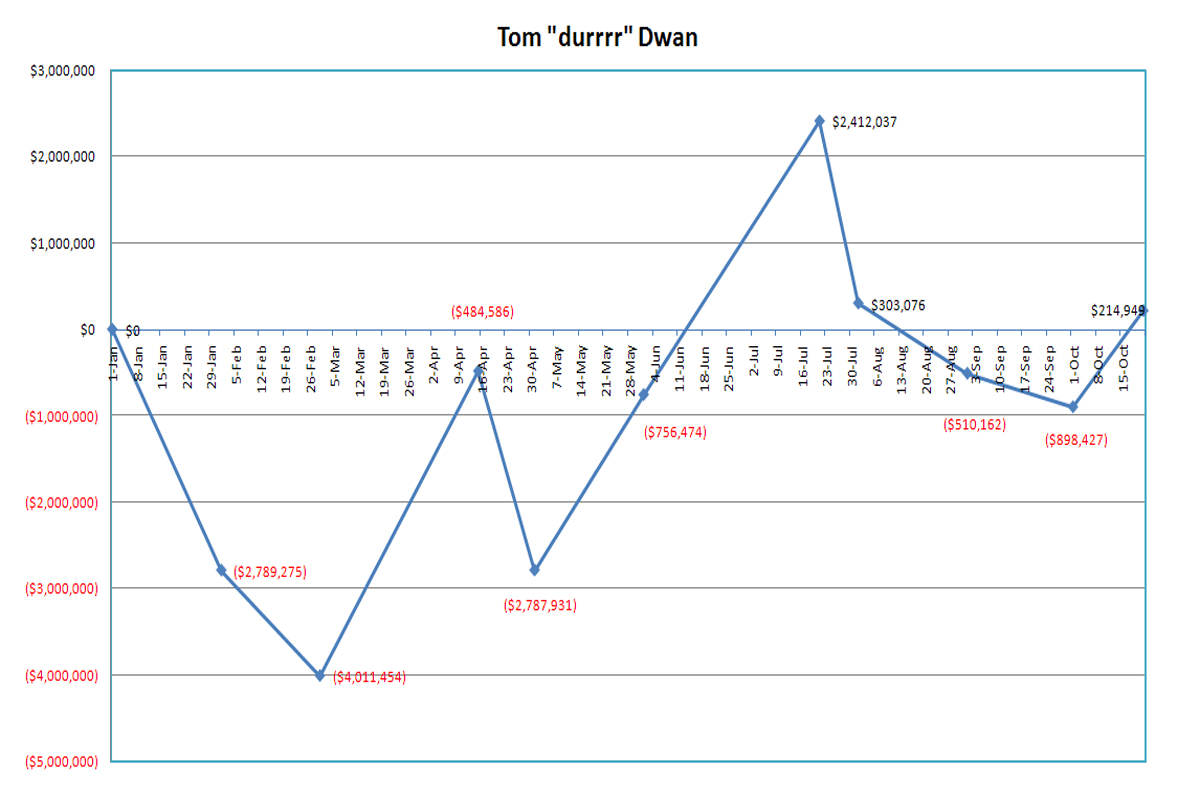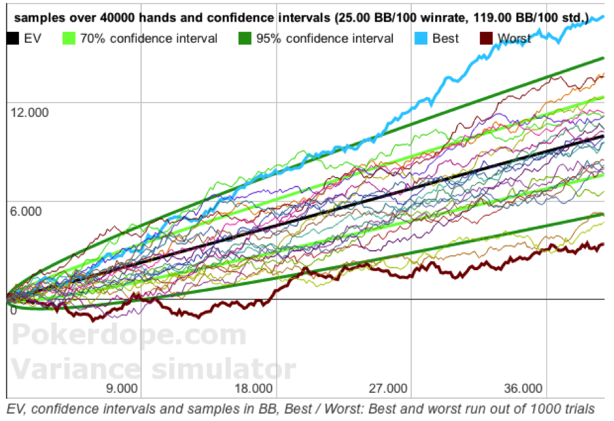Variance is a killer in online poker. The upswings and downswings can affect your mood, put you on tilt, give you a false sense of superiority, and kill your enthusiasm (often all in one game).
Bad variance can make it difficult to assess whether you're doing the right thing or not. On top of that, it's a kick in the teeth to be outdrawn or sucked out on when you know you're playing well.
However, by accepting that variance is part and parcel of this great game, you can work harder to combat it.
Variance is a measure of how data points differ from the mean. According to Layman, a variance is a measure of how far a set of data (numbers) are spread out from their mean (average) value. Variance means to find the expected difference of deviation from actual value. Therefore, variance depends on the standard deviation of the given data set. Pretty simple question. Is it REALLY variance when every bust out hand of the day (16 tournaments) was a result of getting it in good - either preflop - or on the flop - and getting beat by the. Accepting variance mean that you do not get overly affected by stretches of good or bad luck, but simply keep focusing on improving yourself as a player. Playing the best we can at all times and striving to keep improving is a concept that pretty much all serious poker players know about but it is still one of the concepts that people get wrong. Variance as it's called is the pimple on poker that everyone who plays, will experience at some point in their career. Since poker is a game of math and even Aces can lose sometimes, the math dictates that you will lose, there's no running from it. The thing that separates the good players from the bad is how they deal with variance in poker.
Phone Time Variance Meaning
Simply put variance is used to describe the ups and downs of playing poker. A more accurate way to put it is to say that variance is the difference between how much money you expect to win on average in the long run and the actual results you are getting short term.
To use a real example let us say that you get all in preflop holding AA and your opponent is holding KK. You are a 82/18 favourite to win this one. Let us say you lose this all-in, that would be called negative variance, since the short term result is worse than the average expected result. In a $0.10/$0.20 game you would be losing $20 instead of winning $16.40.
If we are the one holding KK and win this all-in vs. AA, then that would be called positive variance, since the short term result is better than the average expected result. We would win $20 instead of losing $16.40.
But let us stick with us losing more than we should right now for the sake of explaining the concept of variance. Let us say that you lose 5 all-ins in a row where you are a 80/20 favourite. You are now on a downswing. Since you have been experiencing way worse results short term than what you can expect on average long term. Simple enough to understand, right?
Here's an infographic to show you realistically just how bad things could go. Using a poker variance calculator I've discovered some fairly brutal statistics. And below I've highlighted some of them according to a player's winrate. I'd encourage anyone to play around with a variance calculator.
You can add your real standard deviation found in most of the popular poker tracking tools. This will give you a more accurate result. For the example below a standard deviation of 85 was used.
If you are a marginal winning player 2.5bb/100 or lower it's actually more likely you will experience some big swings and long breakeven stretches than not. Players with very good win rates (8bb/100) have a much better time but will still drop 20 buy-ins 5% of the time.
Brick and mortar poker players typically get around 30 hands an hour. A good live player could go for months on end without winning. The opposite could be said as well, a bad losing live player could go for months on end winning. This is why variance can be good for the games.
How Can I Beat Variance?
Poker Variance Calc

This is where our bankroll comes into play. If we only had set $50 aside to be playing NL10, we would only need to lose 5 all-ins in a row before we are bust, leaving ourselves no chance to reach the long run where our edge lies.
So instead of playing NL10 with only 5 buy-ins ($50). I would advocate playing with at least 20 buy-ins. The amount you need to play comfortable depends on how much variance your game has and whether or not you are able to replace your bankroll with more of your own money instantly.
Which Game Has The Highest Variance?
There are a few things that influence how much variance a particular game of poker has. But the biggest three are:
1. Your edge, the bigger your skill advantage on your opponents the lower the variance.
2. The amount of players at the table, HU has higher variance than 6-max and 6-max has higher variance than FR etc because you are forced to be playing more hands because of the blinds.
3. The amount of cards people start with, pot-limit omaha (PLO) you start with 4 cards and this game has higher variance than no-limit hold'em (NLH) where each player gets dealt 2 hole cards.
Since the type of game you play as well as the number of players involved often are fixed variables the only variable we can really affect is our edge. We can improve our edge by studying the game, playing worse players and striving to constantly play our a-game.
The Number One Reason People Quit
Ian Taylor and Matthew Hilger has written a great book called The Poker Mindset on the psychology of poker. The book really focus on teaching you the correct mental attitudes for achieving success in poker. I have read it multiples times and it is my favourite book on the subject.
My favourite chapter of the book is called – Understanding And Accepting The Realities Of Poker. The chapter explains that poker is a game of both skill and luck. In the short term luck is king and in the long term skill is king. This means that we should always focus on playing for the long term. They explicitly write:
'If you are looking to make money from poker, you need to play for the long term and accept the short-term risks.'
The number one reason people quit poker is because they cannot accept variance. Understanding variance and accepting variance is really not the same thing. Accepting variance mean that you do not get overly affected by stretches of good or bad luck, but simply keep focusing on improving yourself as a player.


Playing the best we can at all times and striving to keep improving is a concept that pretty much all serious poker players know about but it is still one of the concepts that people get wrong all the time. After taking a few bad beats the natural feeling of frustration will often lead you to go for marginal flips and gambles to try and get back to even as quickly as possible. But really going for marginal flips and gambles will only lower you winrate, which will increase your variance and make your downswing even bigger.

This is where our bankroll comes into play. If we only had set $50 aside to be playing NL10, we would only need to lose 5 all-ins in a row before we are bust, leaving ourselves no chance to reach the long run where our edge lies.
So instead of playing NL10 with only 5 buy-ins ($50). I would advocate playing with at least 20 buy-ins. The amount you need to play comfortable depends on how much variance your game has and whether or not you are able to replace your bankroll with more of your own money instantly.
Which Game Has The Highest Variance?
There are a few things that influence how much variance a particular game of poker has. But the biggest three are:
1. Your edge, the bigger your skill advantage on your opponents the lower the variance.
2. The amount of players at the table, HU has higher variance than 6-max and 6-max has higher variance than FR etc because you are forced to be playing more hands because of the blinds.
3. The amount of cards people start with, pot-limit omaha (PLO) you start with 4 cards and this game has higher variance than no-limit hold'em (NLH) where each player gets dealt 2 hole cards.
Since the type of game you play as well as the number of players involved often are fixed variables the only variable we can really affect is our edge. We can improve our edge by studying the game, playing worse players and striving to constantly play our a-game.
The Number One Reason People Quit
Ian Taylor and Matthew Hilger has written a great book called The Poker Mindset on the psychology of poker. The book really focus on teaching you the correct mental attitudes for achieving success in poker. I have read it multiples times and it is my favourite book on the subject.
My favourite chapter of the book is called – Understanding And Accepting The Realities Of Poker. The chapter explains that poker is a game of both skill and luck. In the short term luck is king and in the long term skill is king. This means that we should always focus on playing for the long term. They explicitly write:
'If you are looking to make money from poker, you need to play for the long term and accept the short-term risks.'
The number one reason people quit poker is because they cannot accept variance. Understanding variance and accepting variance is really not the same thing. Accepting variance mean that you do not get overly affected by stretches of good or bad luck, but simply keep focusing on improving yourself as a player.
Playing the best we can at all times and striving to keep improving is a concept that pretty much all serious poker players know about but it is still one of the concepts that people get wrong all the time. After taking a few bad beats the natural feeling of frustration will often lead you to go for marginal flips and gambles to try and get back to even as quickly as possible. But really going for marginal flips and gambles will only lower you winrate, which will increase your variance and make your downswing even bigger.
Don't be a quitter. Understand and accept that you will be experiencing variance when you play poker, both the good and the bad. But if you continue to improve and focus on getting better and better, then it is only a matter of time before you will be crushing the lowest limits and beyond.